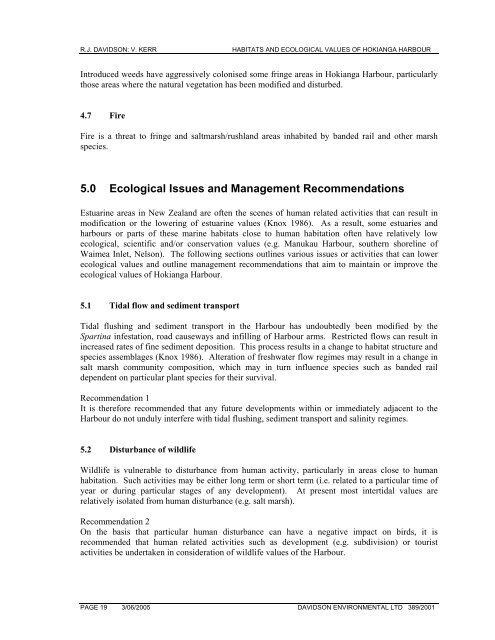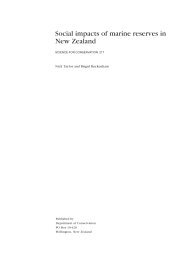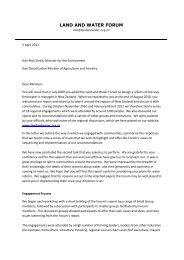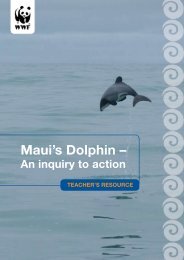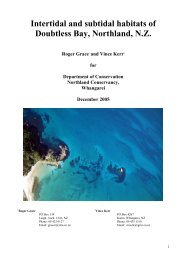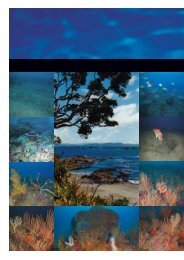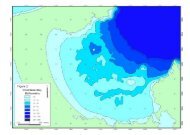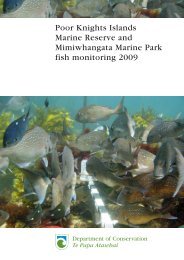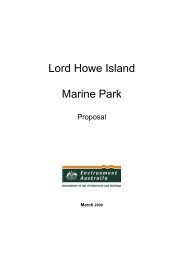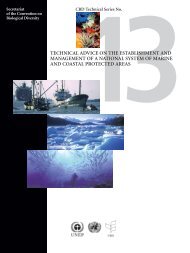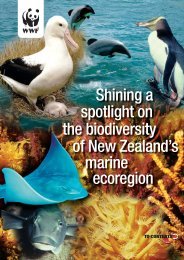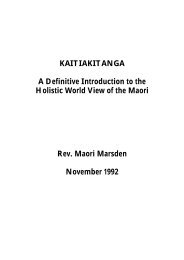Habitats and Ecological Values of the Hokianga ... - MarineNZ.org.nz
Habitats and Ecological Values of the Hokianga ... - MarineNZ.org.nz
Habitats and Ecological Values of the Hokianga ... - MarineNZ.org.nz
You also want an ePaper? Increase the reach of your titles
YUMPU automatically turns print PDFs into web optimized ePapers that Google loves.
R.J. DAVIDSON: V. KERR<br />
HABITATS AND ECOLOGICAL VALUES OF HOKIANGA HARBOUR<br />
Introduced weeds have aggressively colonised some fringe areas in <strong>Hokianga</strong> Harbour, particularly<br />
those areas where <strong>the</strong> natural vegetation has been modified <strong>and</strong> disturbed.<br />
4.7 Fire<br />
Fire is a threat to fringe <strong>and</strong> saltmarsh/rushl<strong>and</strong> areas inhabited by b<strong>and</strong>ed rail <strong>and</strong> o<strong>the</strong>r marsh<br />
species.<br />
5.0 <strong>Ecological</strong> Issues <strong>and</strong> Management Recommendations<br />
Estuarine areas in New Zeal<strong>and</strong> are <strong>of</strong>ten <strong>the</strong> scenes <strong>of</strong> human related activities that can result in<br />
modification or <strong>the</strong> lowering <strong>of</strong> estuarine values (Knox 1986). As a result, some estuaries <strong>and</strong><br />
harbours or parts <strong>of</strong> <strong>the</strong>se marine habitats close to human habitation <strong>of</strong>ten have relatively low<br />
ecological, scientific <strong>and</strong>/or conservation values (e.g. Manukau Harbour, sou<strong>the</strong>rn shoreline <strong>of</strong><br />
Waimea Inlet, Nelson). The following sections outlines various issues or activities that can lower<br />
ecological values <strong>and</strong> outline management recommendations that aim to maintain or improve <strong>the</strong><br />
ecological values <strong>of</strong> <strong>Hokianga</strong> Harbour.<br />
5.1 Tidal flow <strong>and</strong> sediment transport<br />
Tidal flushing <strong>and</strong> sediment transport in <strong>the</strong> Harbour has undoubtedly been modified by <strong>the</strong><br />
Spartina infestation, road causeways <strong>and</strong> infilling <strong>of</strong> Harbour arms. Restricted flows can result in<br />
increased rates <strong>of</strong> fine sediment deposition. This process results in a change to habitat structure <strong>and</strong><br />
species assemblages (Knox 1986). Alteration <strong>of</strong> freshwater flow regimes may result in a change in<br />
salt marsh community composition, which may in turn influence species such as b<strong>and</strong>ed rail<br />
dependent on particular plant species for <strong>the</strong>ir survival.<br />
Recommendation 1<br />
It is <strong>the</strong>refore recommended that any future developments within or immediately adjacent to <strong>the</strong><br />
Harbour do not unduly interfere with tidal flushing, sediment transport <strong>and</strong> salinity regimes.<br />
5.2 Disturbance <strong>of</strong> wildlife<br />
Wildlife is vulnerable to disturbance from human activity, particularly in areas close to human<br />
habitation. Such activities may be ei<strong>the</strong>r long term or short term (i.e. related to a particular time <strong>of</strong><br />
year or during particular stages <strong>of</strong> any development). At present most intertidal values are<br />
relatively isolated from human disturbance (e.g. salt marsh).<br />
Recommendation 2<br />
On <strong>the</strong> basis that particular human disturbance can have a negative impact on birds, it is<br />
recommended that human related activities such as development (e.g. subdivision) or tourist<br />
activities be undertaken in consideration <strong>of</strong> wildlife values <strong>of</strong> <strong>the</strong> Harbour.<br />
PAGE 19 3/06/2005 DAVIDSON ENVIRONMENTAL LTD 389/2001


